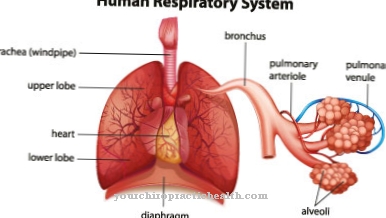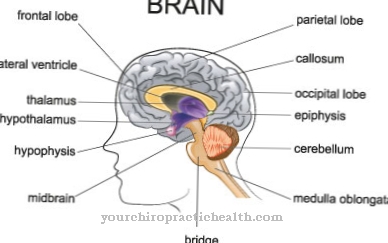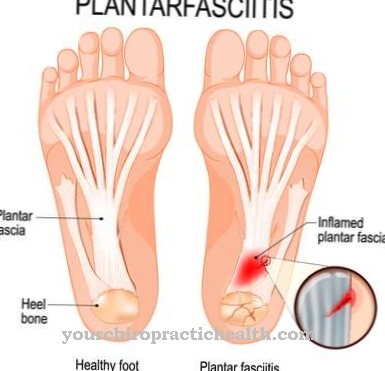A embolism Often formed when a blood clot clogs a blood vessel. Most of the time, this clot, also known as a plug, is triggered by an illness. In the most common known and recorded cases, embolism occurs during or after a thrombosis.
What is an embolism?

© Spectral-Design - stock.adobe.com
Under no circumstances should an embolism be confused with a thrombosis. Although an embolus often develops from a thrombus, there are still two different clinical pictures.
In the case of a thrombosis, the obstructing clot (called a thrombus) usually forms directly at the site of the complaint. In the case of an embolism, a smaller clot often forms at the beginning, but it loosens and moves around in the vessels. In doing so, it can enlarge and eventually block another vessel.
Veins and arteries can be affected by an embolism. Hence there is both an arterial and a venous embolism. A distinction is usually made here by the place of origin of the embolus.
causes
The most common cause of embolism is a thrombosis in the legs or pelvis. A small plug often forms here, but it loosens quickly and then “wanders around” in the arteries or veins.
In most cases, these clots eventually become trapped in the arteries or veins in the lungs, causing the lungs to embolize.
However, the heart, kidneys, and even muscles can also be affected.
In addition to venous and arterial embolism, there are other types of embolism. One example would be bacterial embolism. In this case, the clot is also contaminated with bacteria.
Symptoms, ailments & signs
The symptoms of an embolism depend on the region of the body where the vascular occlusion occurs. Often there are obstructions to the blood flow, which in turn has a negative effect on the affected organs. In addition, there is a risk of tissue death. If, on the other hand, the embolism shows up in areas of the body in which effective bypass circuits are present, a symptom-free course without physical impairment is also possible.
However, in many cases, the affected people experience sudden pain. If the embolism causes a blockage of a blood vessel, this leads to typical symptoms. For example, if a large artery on the arm or leg is affected, the symptoms are usually pain, paleness, sensory disturbances, pulse failure, paralysis and shock.
If a brain embolism occurs, it leads to a stroke. This manifests itself among other things through paralysis and unconsciousness. An embolism in the coronary arteries, which can cause a heart attack, is rather rare.
Sometimes embolisms also appear in the intestines and trigger various complaints. A kidney embolism leads to a kidney infarction, which is associated with pain and blood in the urine. Severe symptoms threaten an embolism in the intestinal mesentery, such as a mesenteric infarction, in which the patient suffers from severe abdominal pain, fever and bloody diarrhea.
A pulmonary embolism, in turn, results in symptoms such as abrupt shortness of breath, palpitations, drop in blood pressure, accelerated breathing and circulatory shock. In the worst case, overloading the heart can even lead to death.
Diagnosis & course
Diagnosing an embolism is not always easy, as it is often only vaguely noticeable. Here it always depends on the location of the constipation - and how the physical environment reacts to it. The affected person often feels nothing for a long time and then suffers a heart attack.
By the way, muscles and individual organs can also be affected by a heart attack. Unfortunately, a clot can also travel to the heart or brain, where it can cause a stroke or heart attack. Other complaints that lead to a diagnosis can include pain and numbness in the affected area.
A doctor should be consulted quickly, especially in the case of high-risk patients and unusual complaints. Elderly people, smokers and people who suffer from diabetes, high blood pressure or very overweight are considered to be at risk.
Complications
An embolism has a wide variety of causes, which can also have a wide variety of complications. Typically, embolisms develop as a result of thrombosis, which mostly occurs in the leg veins. The blood clot can become detached from the vessel wall and carried along with the bloodstream to the lungs, causing pulmonary embolism.
The affected person suffers from shortness of breath and has severe chest pain, which must be treated immediately. In the worst case, the patient dies. An embolism in the area of the arms can lead to a severe insufficient supply of these, which can result in restricted movement. In the worst case, this leads to the loss of the respective extremity.
Furthermore, the embolism can also take place in the kidney or spleen area. There is a loss of function and failure of these organs. The blood vessels in the intestine can also become blocked. This leads to an intestinal infarction and thus to death of the intestinal section.
This can lead to inflammation, which in the worst case can spread systemically and thus lead to life-threatening sepsis. Embolism can also lead to various symptoms of paralysis or cramps in the brain area. In certain vessels, this can also lead to a stroke.
When should you go to the doctor?
If the first signs of an embolism are noticed, an emergency call must be made immediately. First aiders should provide first aid directly on site and calm the affected person and, if necessary, provide medication. A medical emergency is when symptoms include difficulty breathing, shortness of breath, chest pain, severe cough, and restlessness. The following applies to these complaints: alert the rescue service and take the measures mentioned. If the person is passed out, their breathing and pulse should be checked to see if there is cardiac arrest.
People with prosthetic hips or legs, spinal cord injuries, severe heart or lung diseases, or malignant tumors are particularly prone to embolism. The same goes for the elderly and stroke patients. People who have survived a pulmonary embolism should also speak to a doctor quickly if they have unusual symptoms. The same goes for women who are pregnant or after a caesarean section. Regular visits to the doctor are indicated after an embolism. In addition, therapeutic advice for the person affected and their relatives may be useful.
Doctors & therapists in your area
Treatment & Therapy
The first step to successful embolism treatment and therapy is releasing the constipation. To do this, however, it must first be found out where exactly the closure is located. For this purpose, medical professionals can now fall back on a large selection of different test procedures.
If, by the way, severe pain is associated with the embolism, these are also switched off during the start of treatment. First aid is not just about finding the lock. At best, you should also find the cause of the formation of the plug and get to the bottom of it.
Once the cause has been found and eliminated, any damage must be treated. This can happen through medication, but also through cures and rehabilitation measures. It depends very much on what triggered the embolism and perhaps even damaged it.
And: Unfortunately, some damage can be irreparable. This is especially true if the embolism has triggered a stroke.
Outlook & forecast
The prognosis of an embolism depends on the location of the blocked vessel in the organism and the size of the blood clot. The localization of a clot near an organ can result in significant disturbances, failures or the premature death of the patient. The organ activity is restricted by the reduced blood supply or collapses in severe cases. In addition, there is a risk of tissue death. This also causes a functional restriction or a failure of the organ function.
In regions that have good bypass circuits, the prognosis of the embolism improves significantly. The blood can choose another alternative route and an adequate supply of the organism is still guaranteed. With a small blood clot, people often go unnoticed that it is there. As the disease progresses, the first signs that become noticeable through circulatory disorders. If a diagnosis is made at this stage, the prognosis is good. Medical care will remove the clot and the patient is considered cured.
Without treatment, the clot will increase in size. It can be transported at any time by the bloodstream to another place in the organism and trigger a blood congestion there. This leads to a life-threatening condition of the person concerned and can become an acute health hazard.
prevention
The only way to prevent an embolism is to keep the risk of it as low as possible. For example, you should refrain from smoking, eat healthily and maintain a normal and healthy weight. Exercise and exercise are of course the best preventive measures.
This is because risk factors such as adult diabetes and being very overweight can be avoided. However, anticoagulant medication and special support stockings can also be used to prevent embolism.
Aftercare
In the case of an embolism, the person concerned is primarily dependent on medical treatment from a doctor. In most cases, the earlier this treatment is started, the better the further course of the disease will be. If left untreated, the affected person can die in the worst case, so that in the case of embolism, an early diagnosis with early treatment is the foreground.
The follow-up care measures are usually very limited. However, the cause of the embolism should be identified and treated further. Further treatment depends on the exact damage caused by the embolism and must reduce it as much as possible. Those affected are mostly dependent on taking medication or various therapies, although not all damage can be treated again.
When taking medication, ensure that the dosage is correct. Many exercises from different therapies can also be performed in your own home, so that healing is accelerated a little. A healthy lifestyle with a balanced diet can also have a positive effect on the further course of the embolism. However, the patient's life expectancy may be reduced by this condition.
You can do that yourself
In the event of an acute embolism, an emergency doctor must be alerted immediately. It is important to calm the person down and watch out for other warning signs. In the case of a pulmonary embolism, the person affected must assume a semi-sitting position; in the case of an embolism in the legs or a stroke, the lying position is recommended.
In the event of a collapse or cardiac arrest, first aid must be provided if possible. The person concerned should then be accompanied to the clinic, as the hospital stay usually lasts several days or weeks. Any damage to the embolism is treated in further treatment steps. In addition to the conventional medical measures, the doctor will recommend physical activity and dietary measures, among other things.
In the case of major health impairments, a psychologist is also consulted with the patient. This is especially necessary if the embolism has triggered a stroke. In such severe cases, relatives are also advised to seek therapeutic advice. At the same time, further measures must be taken to ensure that the person concerned is cared for further. In less severe cases, physiotherapy measures, among other things, are recommended.


.jpg)






















.jpg)

.jpg)
